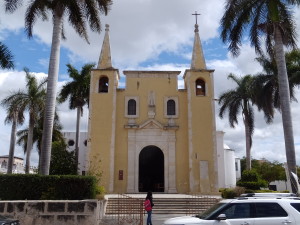Overview of Merida:
Taxi drivers are the first impression of a city. Merida’s came in the form of a short, brown, smiling taxi driver who beamed at us the moment we got out of the car, and said, “Bienvendos a Mérida”. I think he genuinely meant it. It was the beginning of many such encounters. People on the street stopping as you searched a map to ask you if you needed help. Always, they would say welcome to my beautiful city. Sometimes, they would reach out and shake your hand. Often they would give you a history lesson on whatever cathedral was nearby. I don’t mean, just a three or four sentence overview. They could be tour guides. Maybe they moonlight on their days off. All I know. No one wanted anything in return except a promise to explore and learn more about the place.

For you see, Mérida is a city full of ambassadors who are proud of their history and their culture. After love of family, I think it is the next most important thing about who they are.
Merida is flat. Palm trees peek out from interior courtyards of homes and parks abound. Although a thirty-minute drive from the Gulf, there is a tropical breeze in the air. I’ve heard it is a steam bath in April and May. This is February, one of the best times to come to Mérida. Today, it is even a little chilly and I’m glad I brought a thin little jacket. (I will end up wearing that jacket every day of the trip.)
The Paseo de Montejo, a wide boulevard with grand houses and government buildings reminds me of places in Europe. The architecture is a mixture of Italian, French and Spanish. The best way to see the Paseo is to walk, beginning at Calle 47. Walk up to the Monumento a la Bandero on one side of the street, then cross and walk back to the beginning. You can also explore on a horse-drawn carriage (calesa). The Turibus has a stop at the Museum of Anthropoogy at the corner of Calle 43.
Sundays are the best time to explore the older part of the city when streets are closed to cars. It’s a great time for bike riding. Notice all the families out together.
In the Historical Center of town, again you find more of a European influence in the buildings with many in need of a new coat of paint. I’ve never been to Havana, but sometimes a street reminds me of pictures I have seen of it (but with new cars), then one turn later and you find yourself on a new street that has been totally refurbished to its former glory, often by retired Americans and Canadians. The colors are varying degrees of pastels. The streets are made by Mr. Clean: they are spotless. The sidewalks are Mexican: rutted, crumbling in places and definitely warrant caution. I wince at the missing coverings for utilities that lie below the concrete sidewalks. One step in them, well, that would be a vacation-killer.
 Plazas and Parks: There is always something going on in the evenings at most of the plazas. Older people dancing, bands playing, dancing groups performing, festivals, and my favorite, people watching. In Plaza Grande, there is free Wi-Fi.
Plazas and Parks: There is always something going on in the evenings at most of the plazas. Older people dancing, bands playing, dancing groups performing, festivals, and my favorite, people watching. In Plaza Grande, there is free Wi-Fi.  Dean and I shared the white-painted, love seats that are scattered around the park. Enchanting. The main thing: pick a park and park. Listen to a local soloist or a band. Step back in time. It’s only a wee bit but it is enough to recharge your 21st Century soul.
Dean and I shared the white-painted, love seats that are scattered around the park. Enchanting. The main thing: pick a park and park. Listen to a local soloist or a band. Step back in time. It’s only a wee bit but it is enough to recharge your 21st Century soul.
Some cathedrals are really grand but we found this sweet one that didn’t have an ounce of gold in it. 


